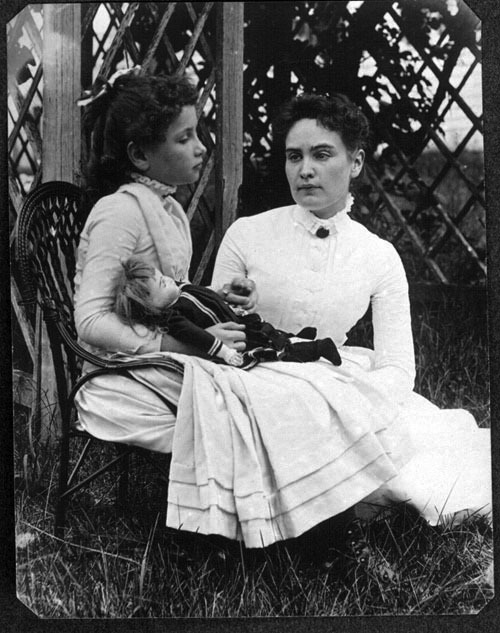#anne sullivan
Text
~ Helen Keller ~
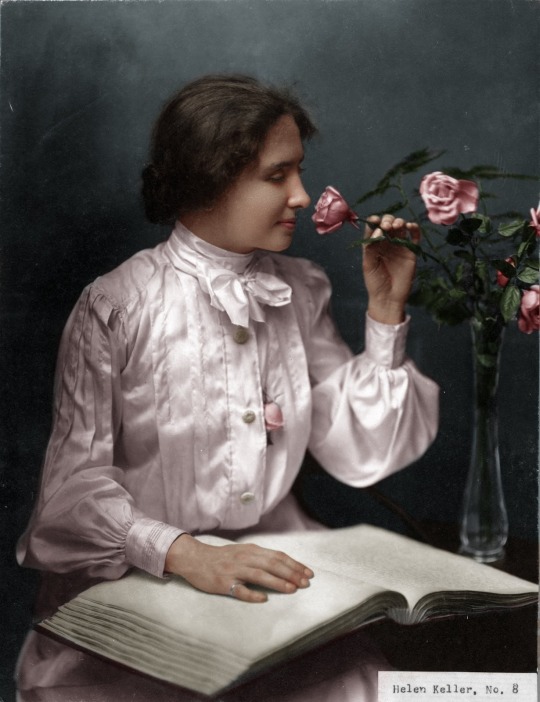
Helen Keller (colorized)
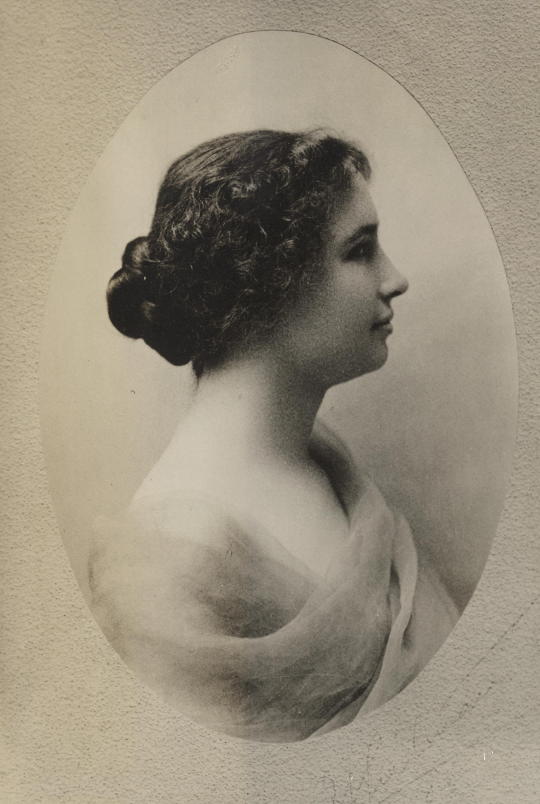
Miss Helen Keller - Portrait US Library of Congress
Helen Keller was an author, lecturer, suffragists and crusader for the handicapped. Born in Tuscumbia, Alabama, She lost her sight and hearing at the age of nineteen months to an illness now believed to have been scarlet fever. Five years later, on the advice of Alexander Graham Bell, her parents applied to the Perkins Institute for the Blind in Boston for a teacher, and from that school hired Anne Mansfield Sullivan.
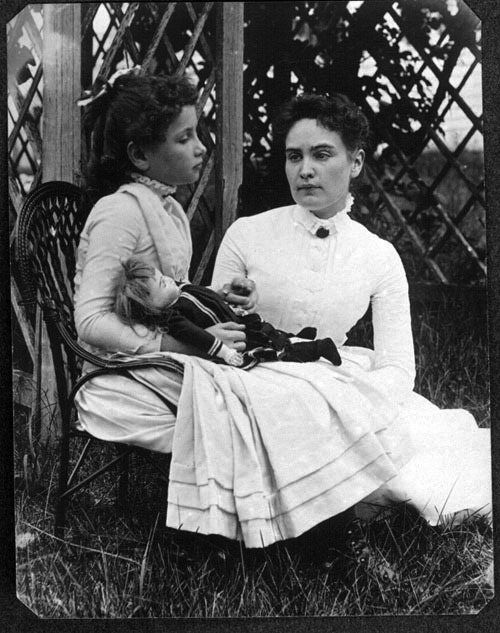
Keller (left) with Anne Sullivan vacationing on Cape Cod in July 1888
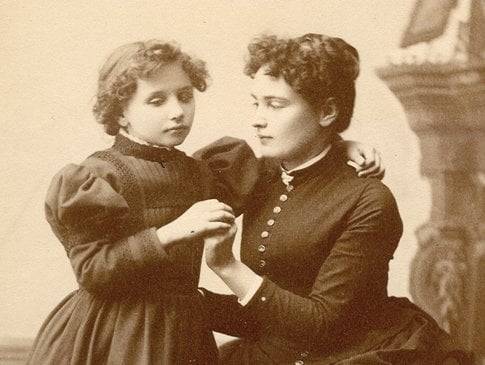
Through Sullivan’s extraordinary instruction, the little girl learned to understand and communicate with the world around her. She went on to acquire an excellent education and to become an important influence on the treatment of the blind and deaf.
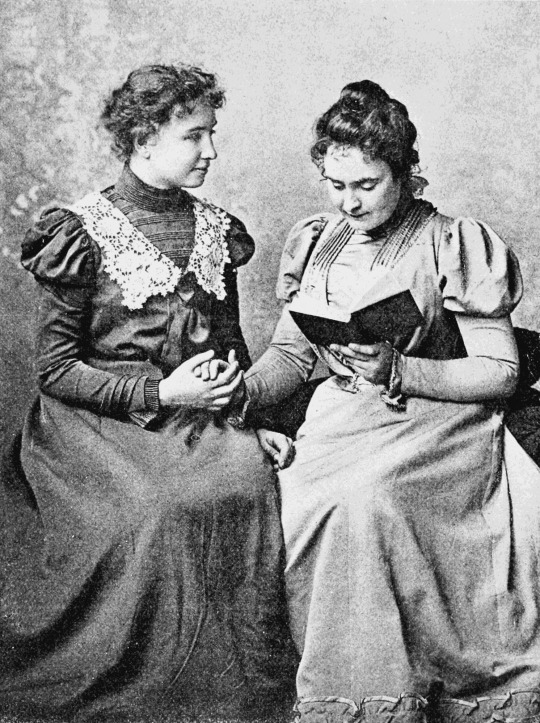
Helen Keller in 1899 with lifelong companion and teacher Anne Sullivan. Photo taken by Alexander Graham Bell at his School of Vocal Physiology and Mechanics of Speech.
Her unprecedented accomplishments in overcoming her disabilities made her a celebrity at an early age; at twelve she published an autobiographical sketch in the Youth’s Companion, and during her junior year at Radcliffe, she produced her first book, The Story of My Life, still in print in over fifty languages.
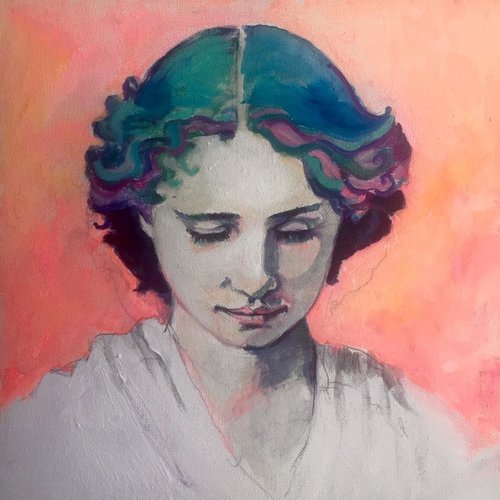
Helen Keller — Groundbreaking Girls
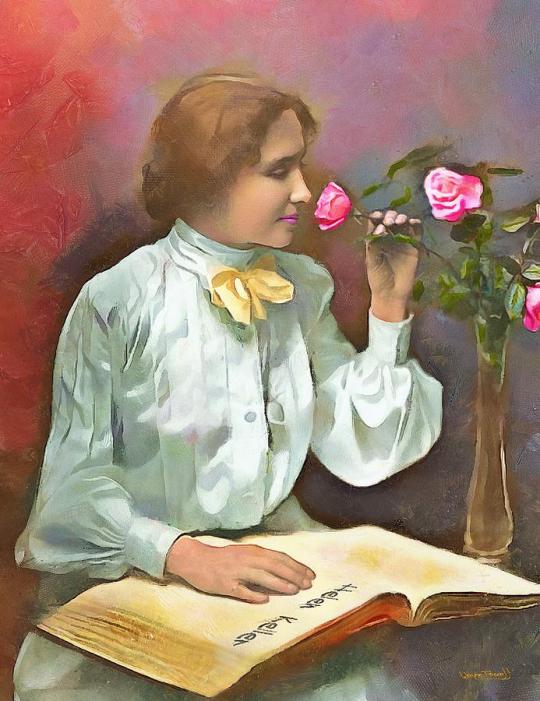
Painting of Keller's colorized portrait by Wayne Pascall
Her friendship with Mark Twain
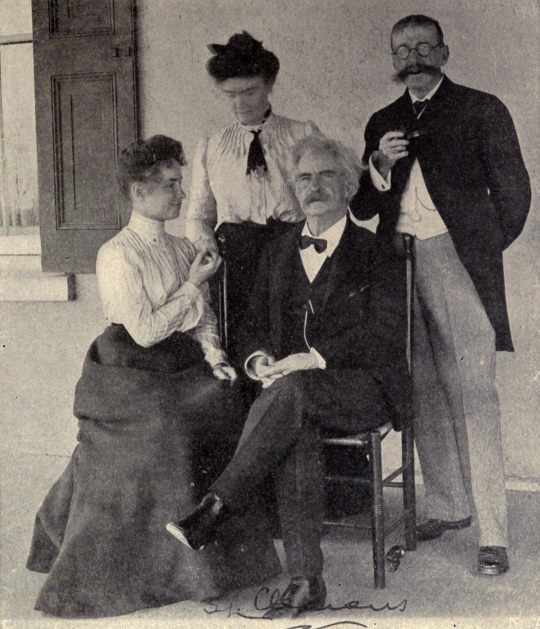
"Helen Keller, Miss Sullivan, Mark Twain and Laurence Hutton."
“From that day until his death we were friends,” Keller recalled later. She was already a fan of his work and thrilled to his deep voice and his many hand gestures, which she followed with her own fingertips. She wrote of him:
"He entered into my limited world with enthusiasm just as he might have explored Mars. Blindness was an adventure that kindled his curiosity. He treated me not as a freak, but as a handicapped woman seeking a way to circumvent extraordinary difficulties. There was something of divine apprehension in this rare naturalness towards those who differ from others in external circumstances."

Helen Keller with Mark Twain - Twain came to Keller’s defense, after reading in her book about a plagiarism scandal that occurred in 1892 when, at only twelve years old, she was accused of lifting her short story “The Frost King” from Margaret Canby’s “Frost Fairies.” Though a tribunal acquitted Keller of the charges, the incident still pissed off Twain. The letter is attached to the photo above
Letters between Mark Twain and Helen Keller.
Though Helen hailed from a respectable Southern family, 19th-century America was flummoxed by the prospect of teaching a deaf-blind girl to talk, read, and learn. Helen’s tutor and governess, Annie Sullivan, fought for her admission to various schools that offered special education. But the cost of educating someone like Helen was high. Clemens wrote to a rich friend on her behalf:
"It won’t do for America to allow this marvelous child to retire from her studies because of poverty. If she can go on with them she will make a fame that will endure in history for centuries. Along her special illness she is the most extraordinary product of all the ages…lay siege to your husband & get him to interest himself and Messrs. John D. & William Rockefeller & the other Standard Oil chiefs in Helen’s case; get them to subscribe an annual aggregate of six or seven hundred or a thousand dollars- & agree to continue this for three or four years, until she has completed her college course…."
Thanks to his intervention, the support of his friend Henry Rogers and Standard Oil, Helen was able to complete her education and graduate cum laude from Harvard’s Radcliffe College. Clemens and Keller remained friends for the rest of his life. They shared an interest in radical politics and a love for life despite their different temperaments. Helen, an avowed optimist, often made fun of Clemens for his avowed pessimism, telling him she didn’t believe a word of his sardonic jokes. As for Clemens, Chambliss writes that he felt she was one of the most important historical figures of all time, “the most wondrous person of her sex that has existed on this earth since Joan of Arc.”
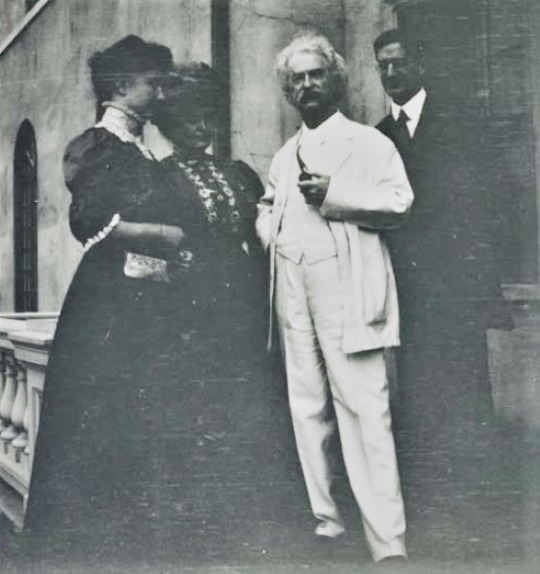
Keller, Sullivan, Twain, & Sullivan’s husband John Macy above at Twain’s home
We also have Twain—not playwright William Gibson—to thank for the “miracle worker” title given to Keller’s teacher, Anne Sullivan. As a tribute to Sullivan for her tireless work with Keller, he presented her with a postcard that read, “To Mrs. John Sullivan Macy with warm regard & with limitless admiration of the wonders she has performed as a ‘miracle-worker.’” In his 1903 letter to Keller, he called Sullivan “your other half… for it took the pair of you to make complete and perfect whole.”
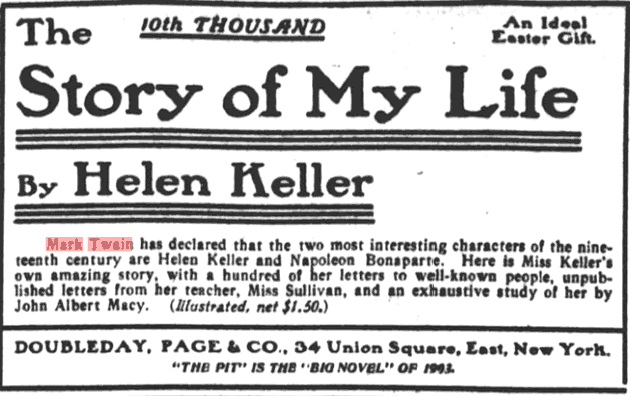
Twain was especially impressed by Keller’s autobiography, writing to her, “I am charmed with your book—enchanted.” (See his endorsement in a 1903 advertisement, above.)
Keller & Clemens also shared a love of dogs
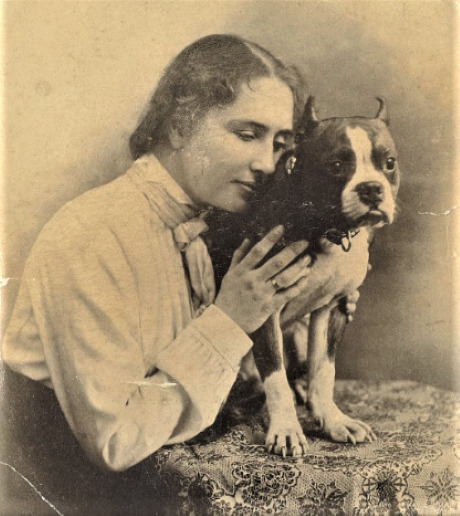
Helen Keller with her dog Sir Thomas.
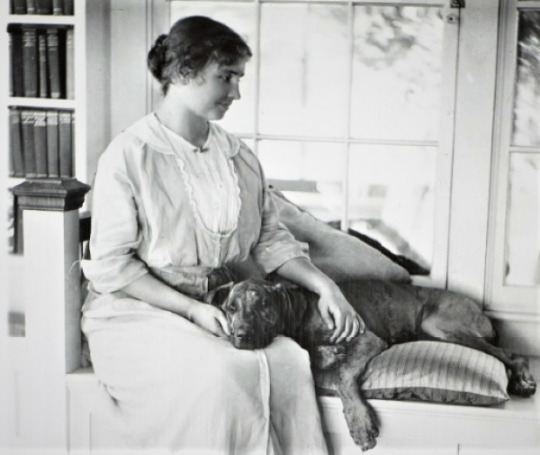
Helen Keller seated on a window bench with an arm around her dog Sieglinde.
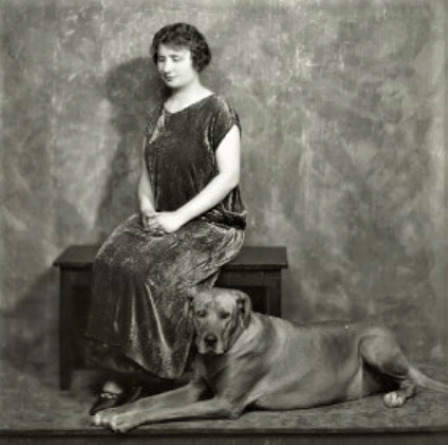
Helen Keller seated on a bench indoors, possibly in the photographer's studio wth a dog seated on the ground beside her.
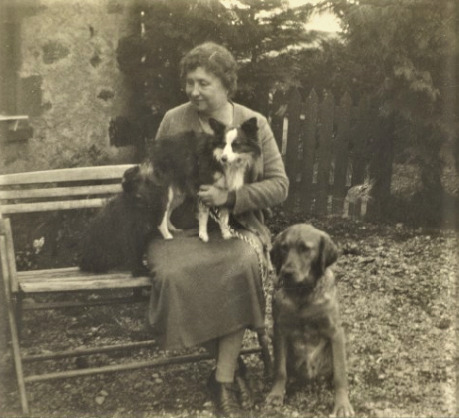
Helen Keller seated on a slatted bench in front of a Farm House in 1935 with her dogs Dileas, on her lap, Maida beside her & Golden.

Helen Keller teaching a girl sign language.
Widely honored throughout the world and invited to the White House by every U.S. president from Grover Cleveland to Lyndon B. Johnson, Keller altered the world’s perception of the capacities of the handicapped. More than any act in her long life, her courage, intelligence, and dedication combined to make her a symbol of the triumph of the human spirit over adversity.

Helen Keller - 1880-1968
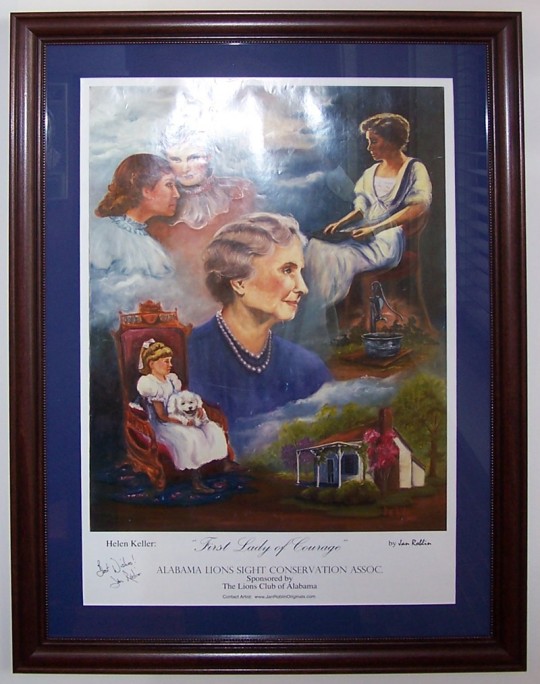
Helen Keller Archive
#helen keller#samuel clemens#mark twain#anne sullivan#anne sullivan macy#john macy#Henry Rogers#blind#sign language#braille#miracle worker#Alexander Graham Bell#Radcliffe College#suffragette#women's suffrage#suffrage#deaf#handicapped#cliff clavin#art
108 notes
·
View notes
Text

On March 3, 1887, Anne Sullivan begins teaching six-year-old Helen Keller.
28 notes
·
View notes
Text
How Did Helen Keller Navigate Her World
An Exploration of Her Visual Aides and Accommodations while in University
Welcome to Part One of my Helen Keller mini-series. In Spring 2022 I took a Disability in Literature class as part of my degree. The focus was on Helen Keller, her writing, her activism, and her complicated legacy.
In Part Two I will discuss her interests in writing, socialism, animals, nature, performing, etc.
In Part Three I discuss the controversies you'll find when researching Helen Keller
While studying Keller’s writings I became fascinated with the occasional mentions of historical visual aids Keller relied on. It was through her autobiography I first learned that there used to be multiple Braille alphabets for the English language, or that raised text was still an incredibly popular printing choice. If you read older posts from my blog, especially Writing a Blind Character in Victorian Era Historical Fiction and I found a lost piece of blindness history you’ll know that historical accommodations have been an interest of mine for a long time.
It was also through this class that I first became aware of the 2020 TikTok #helenkellerwasfake controversy. In 2020 handful of TikTok creators claimed that it was absolutely impossible for a Deaf-blind woman to accomplish everything Keller had done. Among the accusations were that her handwriting was too perfect, she could not have possibly written multiple books, or graduated college.
I believe that the skepticism people have towards Keller’s achievements stems from them not knowing what tools she had to accommodate her disabilities and how she used them. So in this post I’m going to describe all the tools Keller used throughout her life and how they contributed to her education and career.
In this post I'm going to explore:
The Manual Alphabet
Braille and Raised Print
How Accessible was Keller's College Experience
How did Keller Write by Hand
Writing with a Typewriter
Sighted Guides
I also include several quotes from Keller's own writings and I will link those sources here:
The Story of My Life by Helen Keller (1903)
Note: The link I'm providing is to a free copy through The Project Gutenberg, but it isn't exactly the most pleasant reading experience. If you would prefer a print version or an ebook copy of The Story of My Life, you'll probably be able to buy a copy online for cheap.
Midstream My Later Life (1929)
Note: This book is incredibly hard to come by, with printed copies costing 80$ (US) or more, and I cannot find a convenient ebook of it. So I'm providing a link to archive.org which provides different formats for you to download the book in.
The Manual Alphabet
This is the concept that I think is hardest for anyone to conceptualize. The basics of the manual alphabet are that someone finger-spells every word they say with their signing hand held to the listener's hand.
If you know how to finger-spell, I strongly recommend holding your signing hand to the palm of your other hand–we’ll call it the receiving hand. Try finger spelling through the alphabet and focusing on what your receiving hand feels. I use the American Sign Language alphabet, and I will describe how those letters feel to me.
A. I feel four flat, smooth surfaces, about an inch long, maybe a quarter inch wide. Those are my middle phalanges. I can also feel the tip of my thumb sticking up, but that’s a curved surface instead of flat.
B. I feel four cold fingertips touching my hand, but I can’t touch my hands palm to palm because my thumb is in the way, held at a diagonal angle
C. Five slightly-sharp pricks. Those are my fingernails, they’ve grown out recently. There are four pricks on top in a crescent shape and one at the bottom.
D. I feel the cold smoothness of my nails again, but instead of the tips it’s the entire nailbed. There are three on top, one at the bottom.There’s a cold fingertip pressed against my index finger. That is the index finger of the signing hand, making the letter D.
E. Four cool nail beds against my palm and the side of a thumb pressed between hands.
F. Three cold finger tips match up to my pinky, ring, and middle finger. Those are the fingers that stay up for the letter F. The nail bed of a thumb and index finger held together touch the dip where my palm creases are, almost scratchy.
G. The back of an index finger held horizontally along my palm. The fingers of my receiving hand curl over the one finger.
H. This sign is very similar to G, but it’s two fingers instead of one.
I. It feels a lot like A, but the pinky finger extends and touches the tip of my pinky finger.
J. The hand makes the sign for I, and then rotates against my hand, three knuckles grazing my palm, the end of a finger tracing down the side of my hand, along the inside of my wrist, and to my thumb.
K. The index and middle finger press against mine. The side of the thumb touches the shallow valley between my second and third metacarpals. The pinky and ring finger of the signing hand are folded down, pressing against my palm and leaving the last two fingers of my receiving hand the chance to fold down.
L. An index finger pushes against mine while the thumb sits almost horizontally. The knuckles of three fingers are pressed against my palm. The middle, ring, and pinky finger of my receiving hand could fold down around the signing hand.
M. This one is tricky. It feels very similar to A, and it’s only my wrapping receiving thumb over the signing hand that I find the person has folded their thumb into their fist. Folding my entire hand over theirs, I find the nail of the thumb poking between the ring and pinky finger.
N is almost exactly like M, but I find the nail of the thumb sitting between the ring and middle finger.
O feels similar to C, but with C there was an inch or so gap between the nails, and now they’re clustered tightly together
P. The tips of two fingers touch my palm. By closing my palm around theirs I realize that it’s the middle and index finger poking me, and that the thumb is touching the index finger. The ring and pinky finger are curled inwards.
Q is similar to P, but the middle finger has been folded into a fist with the ring and pinky finger.
R. Two finger tips press against one of my fingers, one tip underneath the other in a vertical line. Curling my receiving fingers around the hand, I find that it’s two fingers crossed over each other, the middle finger crossing over the index finger. The pinky and ring finger are curled in, allowing my receiving fingers to fold over their knuckles.
S. A folded fist presses to my palm, but instead of the thumb sitting to the side of it, it’s pressed between the knuckles of those fingers and my hand.
T. This one feels a lot like M and N, but the thumb pokes up between the index and middle fingers
U. Two long fingers press against my index and middle fingers, held tightly together while the remaining fingers and thumb fold into a fist.
V one is like U, but the fingers spread to have a gap between them, literally in a V shape.
W is three fingers press against my hand, a gap between each one. It’s like V in that way, but doubled.
X feels a lot like C, but instead it’s just a thumb and an index finger nail poking into my palm.
Y is the backs of three fingers press against my palm while the thumb and pinky finger of the signing hand press against the thumb and pinky of my receiving hand.
For Z, a cold index finger draws a Z onto my palm.
All these signs are a distinct sensation experience, and with practice Keller began to recognize the differences in the way sighted people recognize the visual differences in their printed alphabets. And like the process of visually reading, where we string together letters in recognizable groups to form words, Keller adapted to stringing touch-letters together into words. Within a few months this method of hand-reading, of sign recognition, became second nature to her. Her vocabulary began to expand and her speed at signing and receiving increased.
Reading Braille and Raised Print
After Keller learned the manual alphabet, Sullivan began using it to read to her. Just as parents read aloud to their hearing children, Sullivan signed every letter into Keller’s palm. In one of her letters to a friend back at the Perkins Institute, Sullivan wrote that she was inspired by how one of Keller’s baby cousins was learning language by listening to her mom, and thought that continuous exposure to language through her hands would give Helen the chance to learn language as fluidly as hearing children. Because Keller was learning words through spelling instead of sound, it wasn’t long before she was reading on her own through both raised print and braille.
Sullivan started teaching Keller to read raised print first because the alphabet resembled printed letters and would allow her to write on her own. She had observed Helen attempting to write letters in an imitation of what Sullivan did in her free time.
Raised print was a prototype to Braille, which was invented by Louis Braille in 1824 while he was a student at Institut National des Jeunes Aveugles, the first ever school for the blind, located in France. Imagine a page of large font and instead of being printed in black ink, the letters are raised. You can trace your fingers over the edges to feel the shape of each letter. But raised print had some weaknesses–
1. The letters had to be printed in a very large font in order for someone to trace each letter with their fingers. This meant each page could only contain a handful of letters and words and every book needed far more paper to be printed in full.
2. Eventually the letters would fade and wear out. Braille letters wear out too, but at a much slower rate. These books did not have much longevity.
Braille had its own weakness in that there was no standardized Braille alphabet for all English speakers until 1932. In The Story of My Life Keller mentions being able to read in multiple varieties of Braille: English; American; and New York Point.
The Accessibility of University in 1900
Helen Keller was determined to go to college, and she wanted to go to Harvard specifically. There were a few problems to this goal: 1. Harvard did not admit female students, but they had a sister school, a women’s college, on the same campus called Radcliffe College. 2. Radcliffe was incredibly competitive, and unlikely to want to accommodate a disabled student. Years later in Midstream, Keller reflects on a dinner party where both Mark Twain (referred to as Mr. Clemens rather than his pen name) and Woodrow Wilson (before his presidency) were in attendance.
“He [Wilson] asked me why I had chosen Radcliffe College rather than Wellesley, Smith, or Bryn Mawr. I said, ‘Because they didn't want me at Radcliffe, and as I was stubborn by nature, I chose to override their objections.’" (Midstream, Chapter Seven, Wanderings, pp. 104)
Keller was only a teenager at the time but she was by then very used to everyone doubting she’d accomplish anything and doing everything in her power to surpass their expectations.
In Chapter 18 of The Story of My Life, Keller describes the experience of preparing for Radcliffe College by attending the Cambridge School for Young Ladies (1896-1899). While there she had a massive struggle obtaining accessible reading materials. The textbooks her teachers assigned had never been printed in raised print or braille before, and though Keller had friends who volunteered to transcribe her reading material, there was never enough time to transcribe all of it. When Keller could not rely on accessible reading material, Anne Sullivan would step in and read to her through the manual alphabet. Sullivan was also present for all of Keller’s lectures to translate what the professors were saying. Keller would listen to Sullivan’s hand and try to remember everything she could, and at night when her classmates were sleeping she would be up transcribing what she remembered into notes she could read.
Only a few of Keller’s teachers over the years learned the manual alphabet to communicate with her directly. In one passage recalling her first year at Cambridge, Keller describes her experience learning German.
“At the Cambridge School the plan was to have Miss Sullivan attend the classes with me and interpret to me the instruction given. - Of course my instructors had had no experience in teaching any but normal pupils, and my only means of conversing with them was reading their lips. My studies for the first year were English history, English literature, German, Latin, arithmetic, Latin composition and occasional themes. Until then I had never taken a course of study with the idea of preparing for college; but I had been well drilled in English by Miss Sullivan, and it soon became evident to my teachers that I needed no special instruction in this subject beyond a critical study of the books prescribed by the college. I had had, moreover, a good start in French, and received six months' instruction in Latin; but German was the subject with which I was most familiar.
In spite, however, of these advantages, there were serious drawbacks to my progress. Miss Sullivan could not spell out in my hand all that the books required, and it was very difficult to have textbooks embossed in time to be of use to me, although my friends in London and Philadelphia were willing to hasten the work. For a while, indeed, I had to copy my Latin in braille, so that I could recite with the other girls. My instructors soon became sufficiently familiar with my imperfect speech to answer my questions readily and correct mistakes. I could not make notes in class or write exercises; but I wrote all my compositions and translations at home on my typewriter. - Each day Miss Sullivan went to the classes with me and spelled into my hand with infinite patience all that the teachers said. In study hours she had to look up new words for me and read and reread notes and books I did not have in raised print. The tedium of that work is hard to conceive. Frau Grote, my German teacher, and Mr. Gilman, the principal, were the only teachers in the school who learned the finger alphabet to give me instruction. No one realized more fully than dear Frau Grote how slow and inadequate her spelling was. Nevertheless, in the goodness of her heart she laboriously spelled out her instructions to me in special lessons twice a week, to give Miss Sullivan a little rest. But, though everybody was kind and ready to help us, there was only one hand that could turn drudgery into pleasure.
That year I finished arithmetic, reviewed my Latin grammar, and read three chapters of Caesar's "Gallic War." In German I read, partly with my fingers and partly with Miss Sullivan's assistance, Schiller's "Lied von der Glocke" and "Taucher," Heine's "Harzreise," Freytag's "Aus dem Staat Friedrichs des Grossen," Riehl's "Fluch Der Schonheit," Lessing's "Minna von Barnhelm," and Goethe's "Aus meinem Leben." I took the greatest delight in these German books, especially Schiller's wonderful lyrics, the history of Frederick the Great's magnificent achievements and the account of Goethe's life. I was sorry to finish "Die Harzreise," so full of happy witticisms and charming descriptions of vine-clad hills, streams that sing and ripple in the sunshine, and wild regions, sacred to tradition and legend, the gray sisters of a long-vanished, imaginative age—descriptions such as can be given only by those to whom nature is "a feeling, a love and an appetite." (The Story of My Life, Chapter 18)
I think it’s worth noting that Keller both enjoyed and excelled in German because her teacher was willing to learn the manual alphabet to accommodate her. The direct communication nurtured her interest and streamlined Keller’s learning experience, even if the teacher was not the most fluent signer. When Keller took her exams later that year, German was one of her most successful subjects.
“I took my preliminary examinations for Radcliffe from the 29th of June to the 3rd of July in 1897. The subjects I offered were Elementary and Advanced German, French, Latin, English, and Greek and Roman history, making nine hours in all. I passed in everything, and received "honours" in German and English.”
I recommend reading The Story of My Life if you want to learn more about her experience at college, the struggles she experienced, the memories she made, what she read, what she enjoyed or disliked about college. The Story of My Life was written during her sophomore year of college, so those accounts of her struggles were fresh in her memory and ongoing. If you yourself are a student, I think you will relate to some of what she writes.
Writing by Hand
In one of her letters, Anne Sullivan describes the process of teaching Helen to write with a pencil on paper:
“I put one of the writing boards used by the blind between the folds of the paper on the table, and allowed her to examine an alphabet of the square letters, such as she was to make.”
Unfortunately I couldn’t find a photo, drawing or description of the writing board, so I will have to make some speculation based off my past research into historical accessibility tools. I believe the board was designed to sit underneath the page and that it had grooves carved into it. These grooves were a little less than an inch tall and stretched horizontally from one edge of the board to the other. The grooves resembled the blank space between lines we see on lined paper today. The separating lines remained raised, creating boundaries for the pencil to stop so that a person could write in a straight line.
When we teach blind students to write by hand today, we teach them a style of penmanship where the tip of a pencil never leaves the page. The letters are very blocky and have a line at the bottom that connects one letter to the next.
Here is a photo of Helen Keller’s handwriting when she was a child:

[Image Description: a yellowed page with pencil writing that fills the entire page and reads: “South Boston Mass. Nov. 7, 1889. Mon cher Monsieur Anagnos. Today is your birthday and how I wish I could put my two arms around your neck and give you many sweet kisses, but I cannot do that because you are far away, so I will write you a nice long letter, and when you come home I will give you the kisses. Now I am going to tell you something which will surprise you very much. I came to Boston three weeks ago to study with my dear teacher. I was delighted to see all of my friends again and they were glad to see me. I miss you and I hope you will come back soon.” End Image Description]
(Photo Source)
If you’re familiar with the 2020 TikTok controversy where several TikTok creators claimed Helen Keller wasn’t real, you might know that someone specifically pointed out her handwriting and said it was too perfect to have come from a deaf-blind woman. And this handwriting is perfect. Every letter is written super carefully, hesitantly. The lines of penmanship on this are also unnaturally straight on a page with no visible lines. Sighted people cannot write that straight, they veer off and write slightly diagonally and have uneven space between their words because there is nothing on the page to set a clear boundary.
A blind writer who positions a writing board underneath their papers will have built in lines they can feel as they write but we cannot see. Note where her lowercase letters have
And if you observe her lowercase Y’s, P’s and G’s you might notice that some have an odd indent on the line, like something disrupted Keller’s otherwise smooth handwriting. That’s the slightly raised line on the board behind her page. “Delighted” “surprised” and “glad” are excellent examples of where that disruption is most noticeable.
It’s also worth noting that Helen Keller’s handwriting style remained unchanged throughout her entire life. Here is a sample from when she was older:
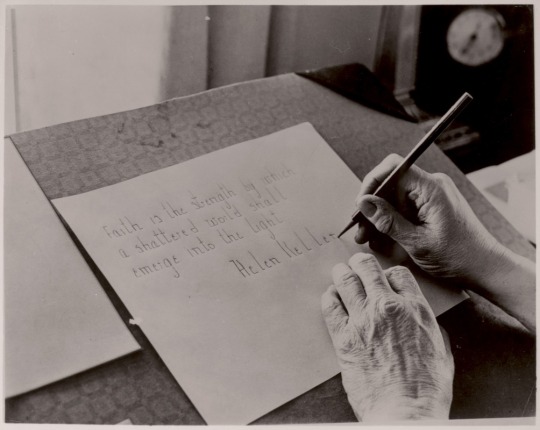
[Image Description: On a slanted writing surface is a piece of write paper where Helen Keller has written: “Faith is the strength by which a shattered world shall emerge into the light. Helen Keller.” Both her hands are pictured in the photo. Her left hand is holding the page steady while her right hand finishes writing her signature. Her hands are wrinkled with age. End Image Description]
(Photo Source)
The photo is dated from the year 1930, so Keller would be fifty years old in this photo. Her hand writing is nearly identical to the older sample. She favors sharp corners for her M’s, N’s, and H’s instead of soft curves. Her T’s and L’s have little tails at the bottom pointing to the right, like her pencil was drawing the line downward, hit a bump and moved to the right to prepare for the next word.
Now there are no visible lines on the surface the photo is held to, but this photo is not a candid. Many photos of Keller are posed with the photographer and her translator telling her how to position her body and face. The page was probably written with a writing board ahead of time and then posed on a writing desk that would photograph well.
But handwriting doesn’t stagnate for forty years like that. Sighted girls change up their style all the time for aesthetic purposes. Keller’s handwriting is purely functional. The little tails at the beginning and end of letters look decorative but they function to prepare her pencil to write the next letter as smoothly as possible. Muscle memory is guiding where and how her hand moves.
Writing by Typewriter
When it came to her writing, Helen Keller favored her typewriter. It was faster than brailling everything by hand and accessible to sighted readers, which was what mattered when it came to her goals to become a professional writer. She became a proficient typist with practice, much like sighted people today with their laptop keyboards, typing away with their eyes on the screen instead of roaming across the keyboard.
You might ask how she learned how to use a typewriter without ever being able to see the keys. I have not yet found any record of Keller describing how she learned to use a typewriter, but I will speculate. The most likely answer is that Anne Sullivan held Helen’s finger to every key and used the manual alphabet to tell her which letter that key produced. It was slow work and a lot of memorization.
I did find an interesting detail about how Keller uses her typewriter from the perspective of her sighted editor, John Macy:
“Although she has used the typewriter since she was eleven years old, she is rather careful than rapid. She writes with fair speed and absolute sureness. Her manuscripts seldom contain typographical errors when she hands them to Miss Sullivan to read. Her typewriter has no special attachments. She keeps the relative position of the keys by an occasional touch of the little finger on the outer edge of the board.” (The Story of My Life, A Supplementary Account, Chapter 2: Personality)
There is also a mention from Keller about what typewriter she liked best while writing The Story of My Life:
“I use the Hammond typewriter. I have tried many machines, and I find the Hammond is the best adapted to the peculiar needs of my work. With this machine movable type shuttles can be used, and one can have several shuttles, each with a different set of characters—Greek, French, or mathematical, according to the kind of writing one wishes to do on the typewriter. Without it, I doubt if I could go to college.” (Chapter 20 of The Story of My Life)

[Image Description: Helen Keller from her Radcliffe years, seated at a narrow wooden table with a Hammond typewriter set on top. One hand is poised on the keys, the other hand is hidden behind the typewriter. Helen’s hair is pulled back in a low bun or braid and her chin is tipped down. She is wearing a dark blouse with poofy sleeves and a shiny satin ribbon tie. Behind her is a bookshelf and floral curtains. End Image Description]
(Photo Source)
Sighted Guides
Helen Keller never used a white cane for the blind. White canes were not popularized until after World War 1, which ended when Keller was almost forty years old and already comfortable with how she navigated the world. She also never had a guide dog despite being a dog lover, despite being so famous that a guide dog school would happily assign her a dog if she applied for one.
Instead Keller relied on sighted guides for her entire life because they offered an advantage that a cane or dog never could–they could use the manual alphabet to translate conversation and describe their surroundings. A cane could never do that, but a hearing-blind person would not need someone to manually describe their surroundings by hand because they could hear nearby conversations and ambient noise like birds chirping and nearby traffic. Sighted guides accommodate her deafness as well as her blindness.
Helen Keller attended every event and location with a sighted guide and translator. For most of her life that guide and translator was Anne Sullivan, but after Sullivan’s death the role was filled by Polly Thompson for many years. After Thompson’s death, the American Foundation for the Blind that employed Keller to help fundraise for their foundation provided trained volunteers who could fill the role.
Extra Reading Material
Along with the two books I've referenced, I think one of the best Helen Keller readings you can pick up is The World I Live In (1908), where Keller describes the sensory experience of how she navigates through her life. It also includes discussions of what her dreams were like.
You can get a free version of it here, but this book can be bought online if you so fancy.
About the author of this post:
Hello, I’m Mimzy. I run a writing advice blog and my most popular subject is teaching writers how to better write blind characters. This includes helping them build interesting blind characters, determine the limits and skills of their characters, brainstorm accommodations for them (especially in fantasy and sci-fi stories) and avoid ableist tropes and phrasing. I am a visually impaired writer and currently I’m in university studying English literature and Disability Studies.
#helen keller#disability#accessibility#disability history#anne sullivan#reference#image description#long post
180 notes
·
View notes
Text

Weekly Manga Sekai no Ijin (週刊マンガ世界の偉人) / Asahi Shimbun Publications (朝日新聞出版) / 12th Aug 2012 issue (Featured historical figure: Helen Keller)
#educational manga#helen keller#anne sullivan#2010s manga#asahi shimbun#週刊マンガ世界の偉人#朝日新聞出版#issue month: august
2 notes
·
View notes
Text
5th April
First Word (After Helen Keller) by Rachel Rooney
Helen Keller, author, disability rights advocate, left wing political activist and lecturer, became the first deaf and blind person to graduate from university in 1904. Rooney’s poem captures the remarkable transformative moment in Keller’s life on this day in 1887 when her hand was held under a flowing water pump by her teacher, the inventive Anne Sullivan, while Anne spelt out the letters for water on Helen’s other palm, effectively translating it for the girl. It was the start of Helen’s journey to literacy and fame.

Source: The 1962 movie The Miracle Worker, starring Anne Bancroft as Anne Sullivan and Patty Duke as Helen Keller.
First Word (After Helen Keller)
This thing she’s feeling/ This thing she’s feeling
is nameless cold/ in her other palm
that can’t be held/ is nameless warm
This unheard sound/ This unseen sound
its unseen lettering/ its unheard lettering
drums her outstretched skin/ drums her outstretched skin
like fingertips./ like drops of rain.
This thing is spilling over./ This thing is spelling water.
Sullivan’s and Keller’s relationship was often combative and tempestuous but the teacher became Helen’s companion long after her educational role had finished and the two remained close until Anne’s death in 1936.
3 notes
·
View notes
Text
her şeyin bir mucizesi vardır, karanlığın ve sessizliğin bile*
7 notes
·
View notes
Text
Helen Keller and Boston Terrier Phiz—

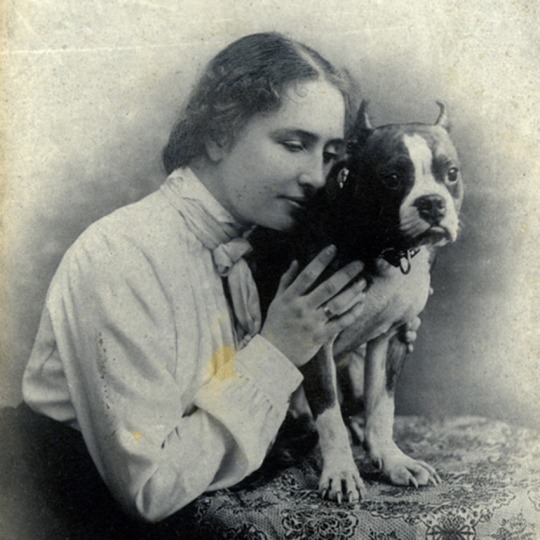
Keller with one of her most famous dogs, a Boston bull terrier named Sir Thomas, more commonly known as Phiz. Keller was given the dog by her classmates at Radcliffe College – an act of generosity that generated newspaper stories around the country. Phiz reportedly accompanied Keller to lectures at Radcliffe and would wait patiently until class was over to return home with her. (Photo 1902.)

With Phiz at their feet, Keller and her teacher/companion Anne Sullivan sit on a wooden platform in a tree near their home in Wrentham, Massachusetts. (Keller could understand what Sullivan was saying by feeling the movement of her mouth.) “My dog friends seem to understand my limitations, and always keep close beside me,” Keller wrote. “I love their affectionate ways and the eloquent wag of their tails.” (Photo circa 1903.)
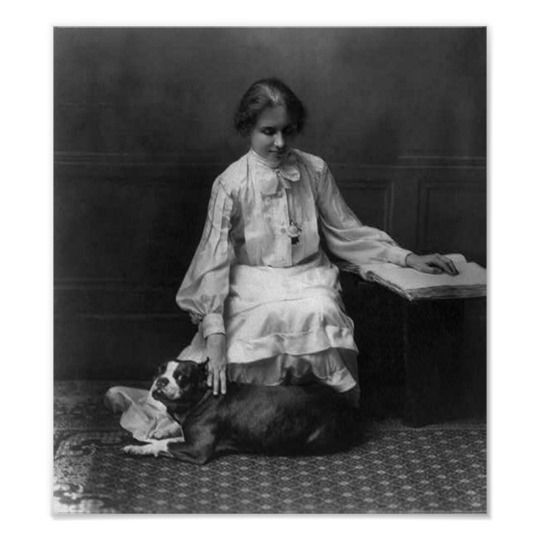
Courtesy: https://www.perkins.org/helen-keller-a-life-with-dogs/
5 notes
·
View notes
Photo

© Paolo Dala
On Failing...
Keep on beginning and failing. Each time you fail, start all over again, and you will grow stronger until you have accomplished a purpose - not the one you began with perhaps, but one you’ll be glad to remember.
Anne Sullivan
1 note
·
View note
Text
Anne Sullivan began teaching six-year-old Helen Keller, who lost her hearing and sight after a dreadful illness at the age of 19 months. March 3, 1887.
Image: Helen Keller (left) in 1899 with lifelong companion and teacher Anne Sullivan (right). Photo taken by Alexander Graham Bell at his School of Vocal Physiology and Mechanics of Speech. (Public Domain).
On this day in history, March 3, 1887,…
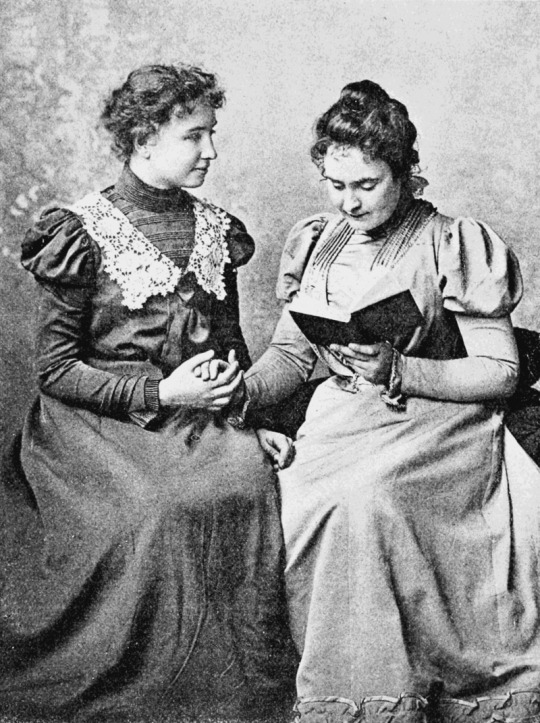
View On WordPress
0 notes
Text

On March 3, 1887, Anne Sullivan began teaching six-year-old Helen Keller, who lost her sight and hearing after a severe illness at the age of 19 months. #OnThisDay
10 notes
·
View notes
Text
Who Was Helen Keller: Her Passions and Interests
Welcome to part two of my mini-series on Helen Keller. I took a Disability in Literature class in Spring 2022 that focused heavily on her legacy.
In Part One, I explain the tools and accommodations Keller needed to navigate the world as a Deaf-blind woman.
In Part Three I will discuss the controversies you stumble upon when you research Helen Keller.
In this class I've learned that the idea we have of who Helen Keller was is not entirely accurate. A lot of people either see her only as the seven year old at the water pump, a scene made famous by the film The Miracle Worker. Or, they see her as this elderly woman who could do no wrong and only wanted to help others, that is the image the American Foundation for the Blind and other similar charities and organizations popularized.
There is about fifty years of interesting content lost in that disconnect and I'm going to bring some of it back. Helen Keller was a writer, a socialist, a suffragette, a dog-lover, a nature enthusiast, and a performer.
I'm going to show you pictures from her life and give you samples of her writing and let you hear her voice.
Writer
In her lifetime, Helen Keller published The Story of my Life (1903); The World I Live In (1908); My Religion (1927) and Midstream My Later Life (1929). There were also more than a dozen small essays published on the subject of socialism and labor rights.
While she was studying English literature at Radcliffe college, she was assigned small autobiographical writing prompts. Her professor liked them so much that he suggested she publish them and got her in contact with the editors of The Ladies’ Home Journal.
“The first part of The Story of My Life was written in the form of daily and fortnightly themes in English 22 at Radcliffe College under Professor Charles Townsend Copeland. I had no idea of publishing them and I do not remember how Mr. Bok became interested in them. I only know that one morning I was called out of my Latin class to meet Mr. William Alexander of the Ladies' Home Journal If I remember rightly, Mr. Alexander said that Mr. Bok wished to publish The Story of My Life in monthly installments. I told him that it was out of the question, as my college work was all I could manage. His answer surprised me. "You have already written a considerable part of it in your themes."
"How in the world did you find out I was writing themes?" I exclaimed. He laughed and said it was his business to find out such things. He talked so optimistically about how easily the themes could be connected to form magazine articles that, without having a very clear idea of what I was doing, I signed an agreement to furnish the Ladies’ Home Journal with The Story of My Life in monthly installments for three thousand dollars. At the moment I thought of nothing but the three thousand dollars. There was magic in those three words. In my imagination the story was already written.” (Midstream My Later Life, Chapter 1, Tuning In, pp. 4-5)
After graduating college, Keller collected all the published pieces of The Story of My Life and sat down to organize them into a full autobiography. After rigorously editing the book, she republished it with new additions, including Anne Sullivan’s letters from her early education and copies of letters she had written when she was a child still learning language.
The money Keller received from publishing her autobiography allowed her to buy her own home in Wrentham, Massachusetts. A few years later she published more autobiographical essays detailing her own experiences navigating the world. It wasn’t just touch, sound, and taste. There are essays about everything she can understand about a person just by touching her hand, about vibrations and what they tell her, about her dreams. These essays were published as a collection and titled The World I Live In.
In the 1910s she published essays on socialism which I will explore more thoroughly in the next section.
Between 1927 and 1929, Keller sat down and chronicled all that the last thirty years had brought her in life, the highs and lows. In it you will find accounts of how she struggled with her career as a public speaker
Socialist
Keller was first introduced to socialism through New Worlds of Old by H. G. Wells, published in 1908. The book was recommended to her by Anne Sullivan, her teacher.
“I read it on Mrs. Macy’s recommendation. She was attracted by its imaginative quality, and hoped that its electric style might stimulate and interest me. When she gave me the book, she was not a socialist and she is not a socialist now” (How I Became a Socialist, 1912).
After finishing New Worlds of Old, Keller approached John Macy for new material. John Macy was Anne Sullivan’s husband and Keller was living with the couple at the time. Unlike his wife, he was an avid socialist with a mini-library of socialist literature. Keller subscribed to multiple socialist magazines. A few times a week a friend would visit her home and read the magazines to her via the manual alphabet.
The world did not respond to Keller’s socialism with delight. Newspapers ran wild printing out articles to respond to this. Some articles speculated that someone was using Keller like a puppet, piggy-backing off her fame to promote the socialist cause. Others argued that Keller’s interest in socialism was a sign of ignorance that stemmed from being deaf-blind and depending on someone else to tell her about the world around her. Macy and Sullivan were often accused of “poisoning Keller’s impressionable mind” with their socialist views. Another argument was that Keller’s interest in socialism stemmed from a deficit in her critical thinking abilities.
As Keller saw it, capitalism generated an abundance of human misery through exploitation. The extreme hours and intensity of labor meant failing health and early death for many. It meant that even when laborers returned home they had too little time to sleep and recover, let alone enjoy their free time. There was no time for family or caring for the home, meaning that living environments were unsanitary and worsened moral.
Keller also recognized that her family’s wealth and her education had given her a privilege to not experience this exploitation herself. But knowing she was safe from that suffering, an exception, was not a comfort.
“I know those men are hungry for more life, more opportunity. They are tired of the hollow mockery of mere existence in a world of plenty. I am glad of every effort that the workingmen make to organize. I realize that all things will never be better until they are organized, until they stand all together like one man. That is my hope of world democracy. Despite their errors, their blunders and the ignominy heaped upon them, I sympathize with the IWWs. Their cause is my cause. While they are threatened and imprisoned, I am manacled. If they are denied a living wage, I too am defrauded. While they are industrial slaves, I cannot be free. My hunger is not satisfied while they are unfed. I cannot enjoy the good things of life that come to me while they are hindered and neglected.” (In Behalf of the IWW, 1918)
And reading that, it’s easy to say “those are pretty words, but did she do anything for them?” Yes, she did. Just giving them her voice gave the IWW a platform. Keller was widely looked upon with admiration, her vocal support was one of the best gifts she could give to social justice causes. Moreover, she utilized the critical thinking skills she developed in college to reason with readers to see the necessity to support those causes.
Here is a link to the Marxist Archive where you can read Keller’s essays discussing socialism
Suffragette
Helen Keller entered her twenties in 1900, graduated from a women’s college in 1904, and became increasingly interested in human rights from 1910 and onward. Unsurprisingly, she was a suffragist. The fight to get women the right to vote was just as important to her as every other fight she participated in.

[Image Description: A newspaper clipping. The headline says: “Helen Keller Riding in the Great Parade of Suffragists in Boston Campaign.” Pictured in black and white is Helen Keller on the left beside another unidentified woman. Both women are wearing hats, and with the sun shining on their backs it casts shadows on their faces. Below the photo is the caption that says: “Helen Keller, shown at the left, was unable to see the crowds that lined Boston’s downtown streets for the recent suffrage parade, in which she was photographed, but her face beamed with smiles as she ‘heard’ the cheers for ‘votes for women’” End Image Description]
(Photo Source)
On June 11, 1916 Helen Keller spoke before the newly formed National Women’s Party, a political party focused on women’s suffrage. From this speech is where the quote “women’s inferiority is man-made” originates but this is my favorite part of the speech:
“The suffrage movement means more than votes for women. It stands for our solidarity. It embodies the ideals and aspirations of the millions of women who think, and whose intelligence and capabilities both men and women respect. We have prayed, we have coaxed, we have begged, for the vote, with the hope that men, out of chivalry, would bestow equal rights upon women and take them into partnership in the affairs of the state. We hoped that their common sense would triumph over prejudices and stupidity. We thought their boasted sense of justice would overcome the errors that so often fetter the human spirit; but we have always gone away empty handed. We shall beg no more. With the ballow [bludgeon or club] in our hands, we demand suffrage for all women.”
(Transcript of Speech)
Keller was famously a pacifist who spoke out against entering the war during World War 1, but this call to arms (metaphorical arms) delights me.
Animal Lover
All her life Helen Keller had dogs by her side. From her earliest childhood years before Anne Sullivan, to her final years, she adored and doted on her dogs.
“Nobody, who is not blind, as much as they may love their pet, can know what a dog’s love really means. Dogs have travelled all over the world with me. They have always been my companions. A dog has never failed me.”
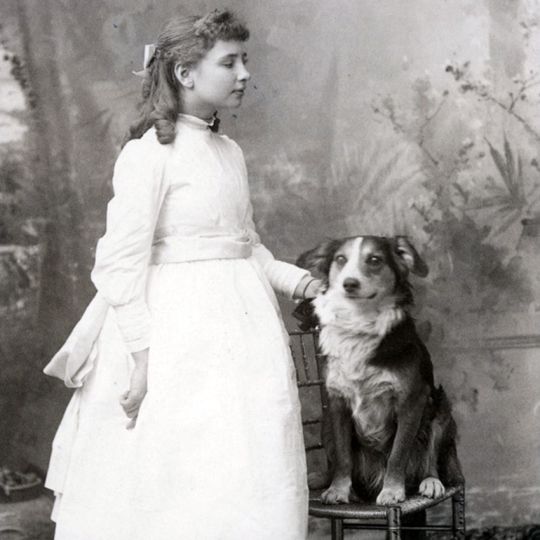
[Image Description: Ten year old Helen Keller in a white dress standing beside a chair. Sitting on the chair is a medium sized dog with a brown and white coat. The dog’s white chest and floppy ears are especially fluffy. Helen has her left hand touching the back of the dog’s neck while her right hand sits at her side. The background is a painted drop cloth used as a background in professional portraits. End Image Description]
Perkins could not confirm which dog this was, but their best guess is that we’re looking at Belle, the dog Keller described as her best friend in her childhood years.
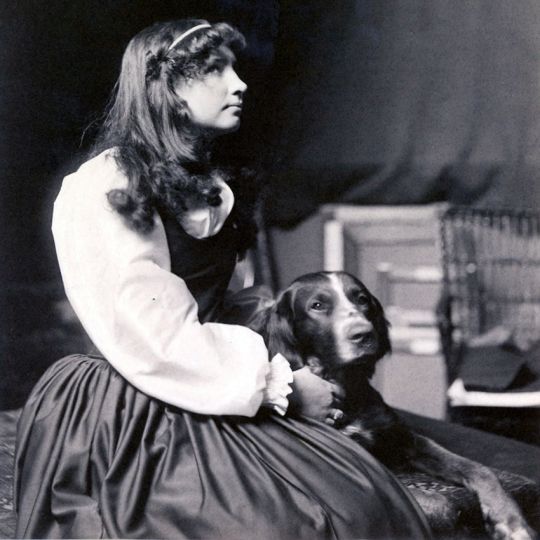
[Image Description: Helen Keller between the ages of thirteen and fourteen. She is sitting with a bull mastiff by her side. The dog’s name is Lioness and she has a dark, shiny coat with a white streak crossing down her forehead and covering her snout. Lioness is positioned behind Keller, lounging with only her head and one front leg visible. Lioness gazes directly at the camera while Keller has her head positioned at a profile angle, chin up. Her hair is down with curls framing her face. End Image Description]
When Helen was attending Radcliffe College, some of her classmates took her on a small adventure into the city with the end goal of surprising her with a gift.
Another episode I like to recall was a surprise my class planned for me. One day several girls invited me to go with them to see some jolly friends in Brookline. That was all they would tell me, and when we reached our destination, they were very mysterious, I began to sniff, and in a moment I realized that instead of a human habitation we were entering a kennel, the abode of many Boston terriers.
The dogs gave us a royal welcome, and one ugly beauty, heir of a noble pedigree, with the title of Sir Thomas Belvedere, bestowed upon me his special favour, planting himself resolutely at my feet, protesting with his whole body if I touched any other dog. The girls asked me if I liked him. I said I adored him.
"Take him home then," they said. "He is our gift to you."
Sir Thomas seemed to understand; for he began spinning round and round me like a top. When he had quieted down a little I told him I did not care much for titles. He assured me that he had no objection to changing his name, and when I told him that I was going to call him Phiz he rolled over thrice by way of showing his approval. So we carried him happily back with us to Cambridge. (Midstream My Later Life, You Oh Youth, page 18-19)

[Image Description: Twenty-two year old Helen Keller sitting while Phiz, a Boston bull Terrier sits on the table beside her. Keller is leaning forward and pressing her face to the dog’s side while her hands wrap around his chest. The dog has a dark coat with a white snout, chesk, and paws. His ears are short and pointed. Keller’s eyes are half closed while the dog looks off to the side. End Image Description]

[Image Description: Twenty-five year old Helen Keller sitting down with her body turned towards the black French bull terrier. This dog is assumed to be Kaiser, and his attention is fully on Keller, looking up at her fondly and bending his head forward to ask for more pets. Helen has her left hand touching the back of Kaiser’s neck, temporarily paused to hold still for the photo. Keller is wearing an Edwardian blouse with three quarter sleeve and a lace collar, as well as a striped skirt. Her clothing and the backdrop of the portrait are both light in color, making Kaiser stand out. End Image Description]
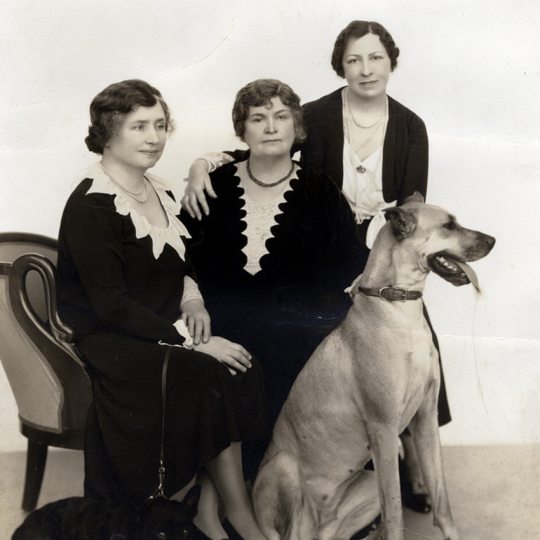
[Image Description: Helen Keller, Anne Sullivan, and Polly Thompson sitting on a fainting couch with a Great Dane named Sieglinde sitting in front of them. Sieglinde has a light coat with darker markings around her snout and ears. All three women are dressed in black dresses with white accents, each wearing her hair in finger waves, a style popular to the twenties. Thompson has her arm wrapped around Sullivan’s shoulder while Sullivan rests her hand on Keller’s. End Image Description]
In 1937 Helen Keller traveled to Japan for the first time. While there she first heard of akitas, a dog breed in Japan, and heard the story of Hachiko. “During her visit, she heard about Hachiko, a famous Akita who had died two years earlier. Hachiko was renowned for his exceptional loyalty. The dog had accompanied his owner to the train station every morning and met him there again every afternoon. Then one day, while away at work in Tokyo, the owner passed away. But that didn’t stop Hachiko. Until his own death almost ten years later, Hachiko went to the station every single evening to search for his beloved owner until his own death.” (link to American Kennel Foundation article quoted)
The Japanese government gifted Keller with an akita puppy named Kamikaze-Go.

[Image Description: Helen Keller and Polly Thompson fawn over an akita puppy named Kamikaze-Go. The dog is standing on his hind legs with his front paws balanced in Polly Thompson’s hands. His head is pressed up to Keller’s chest as he looks up at Thompson. Kamikaze-Go has light fur with dark markings around his snout and ears. End Image Description]
Keller was enamored with him, calling him “an angel in fur.”
Unfortunately Kamikaze-Go contracted canine distemper and died at seven months old. We modern dog lovers are lucky because now there’s a vaccine to prevent tragedies like this. Keller was devastated.
Two years later the Japanese government acquainted Keller with Kamikaze-Go’s younger brother, named Kenzan-Go. It was love at first sight. Keller nicknamed him Go-Go and doted on him. Through watching her, the American public became aware of the akita breed and began to love them too. Akitas became more popular in the U.S., became a recognized breed, and entered dog shows.
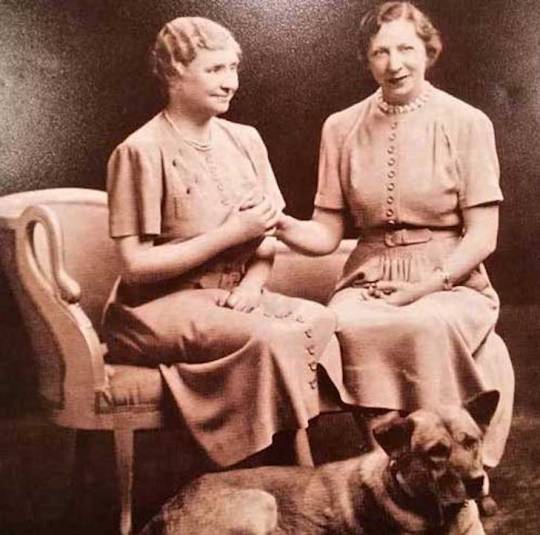
[Image Description: Helen Keller and Polly Thompson are seated together on a fainting couch, the same one from the photo of Keller, Sullivan, and Thompson over ten years ago. Go-Go lays on the ground by their feet. He has a medium colored coat that appears to get darker along his back and his ears. Keller’s right hand is wrapped around Thompson’s hand. Thompson looks almost directly at the camera while Keller looks to the side. End Image Description]
Nature Enthusiast
Keller’s love of nature started long before Anne Sullivan arrived in her life. Growing up on a post-Civil War plantation, there was an abundance of fields and gardens for Keller to explore on her family’s land. Keller’s most used senses were touch and smell and she received an abundance of stimulation in the fragrant gardens surrounding her home.
“I never smell daises without living over again the ecstatic mornings that my teacher and I spent wandering in the fields, while I learned new words and the names of things. Smell is a potent wizard that transports us across a thousand miles and all the years we have lived. The odor of fruits wafts to me my Southern home, to my childish frolics in the peach orchard.” (The World I Live In and Optimism - Chapter Six. Smell, the Fallen Angel)
In this chapter of The World I Live In, Keller approaches the subject of nature conservation, firmly planting herself as someone who believes the exploitation of natural resources such as lumber strips Mother Earth of the natural facets that make her so enjoyable to live on. The message is not new, Native American tribes have advocated for the preservation of natural resources for centuries and practiced sustainable living long before colonization began. Keller is adding her voice to the fight, and doing it in an emotional, sentimental way. She takes you through the moment of realizing the forest you love has been stripped into pieces for industry.
“The other day I walked toward a familiar wood. Suddenly a disturbing odour made me pause in dismay. Then followed a peculiar, measured jar, followed my a dull, heavy thunder. I understood the odour and jar only too well. The trees were being cut down. We climbed the stone wall to the left. It borders the wood which I have loved so long that it seems to be my peculiar possession. But today an unfamiliar rush of air and an unwonted outburst of sun told me that my tree friends were gone.”
When Keller bought her first home in Wrentham, Massachusetts, she had dreams of having her own farm. She kept chickens, had a horse, and planted an apple orchard. She wasn’t exactly skilled at farm labor, and in fact had more failures than success on that front. However, that relationship with nature gave her genuine happiness.
In Midstream My Later Life you’ll find mentions of adventurous hikes she took with Mark Twain on his property, getting lost and having to wander onto the main road to find their way back home.
“We [Keller with Anne Sullivan, her husband John Macy, and Mark Twain, referred to as Mr. Clemens] wandered on and on, forgetful of time and distance, beguiled by stream and meadow and seductive stone walls wearing their autumn draperies of red and gold vines a little dimmed by rain and snow, but still exquisitely beautiful When we turned at last, and started to climb the hill, Mr. Clemens paused and stood gazing ever the frosty New England valley, and said, "Age is like this, we stand on the summit and look back over the distance and time. Alas, how swift are the feet of the days of the years of youth." We realized that he was very tired.
Mr. Macy suggested that he should return cross-lots and meet us on the road with a carriage. Mr. Clemens thought this a good idea, and agreed to pilot Mrs. Macy and me to the road, which he had every reason to suppose was just beyond that elephant of a hill. Our search for that road was a wonderful and fearsome adventure. It led through cowpaths, across ditches filled with ice-cold water into fields dotted with little islands of red and gold which rose gently out of the white snow. On closer inspection we found that they were composed of patches of dry goldenrod and huckleberry bushes. We picked our way through treacherously smiling cart roads. He said, "Every path leading out of this jungle dwindles into a squirrel track and runs up a tree." The cart roads proved to be ruts that ensnared our innocent feet Mr, Clemens had the wary air of a discoverer as he turned and twisted between spreading branches of majestic pines and dwarfed hazel bushes. I remarked that we seemed to be away off our course. He answered, "This is the uncharted wilderness. We have wandered into the chaos that existed before Jehovah divided the waters from the land. The road is just over there," he asserted with conviction. "Yes," we murmured faintly, wondering how we should ever ford the roaring, tumbling imp of a stream which flung itself at us out of the hills.
“There was no doubt about it. The road was just there "where you see that rail fence." Prophecy deepened into happy certainty when we saw Mr. Macy and the coachman waiting for us. "Stay where you are," they shouted. In a few seconds they had dismembered the rail fence and were transporting it over the field. It did not take them long to construct a rough bridge, over which we safely crossed the Redding Rubicon, and sure enough, there was the narrow road of civilization winding up the hillside between stone walls and clustering sumachs and wild cherry trees on which little icicles were beginning to form like pendants. Half way down the drive Miss Lyon met us with tearful reproaches. Mr. Clemens mumbled weakly, "It has happened again the woman tempted me."
I think I never enjoyed a walk more. Sweet is the memory of hours spent with a beloved companion.” Midstream My Later Life, Chapter 4, Our Mark Twain pp. 61-63)
In The Story of My Life you’ll read about the outdoor lessons Anne Sullivan took Keller on, her first jaunt into the ocean, her experience riding horses and hiking through the woods with Sullivan and her sister.
“One summer I had my pony at Fern Quarry. I called him Black Beauty, as I had just read the book, and he resembled his namesake in every way, from his glossy black coat to the white star on his forehead. I spent many of my happiest hours on his back.
Occasionally, when it was quite safe, my teacher would let go the leading-rein, and the pony sauntered on or stopped at his sweet will to eat grass or nibble the leaves of the trees that grew beside the narrow trail. On mornings when I did not care for the ride, my teacher and I would start after breakfast for a ramble in the woods, and allow ourselves to get lost amid the trees and vines, with no road to follow except the paths made by cows and horses. Frequently we came upon impassable thickets which forced us to take a round about way. We always returned to the cottage with armfuls of laurel, goldenrod, ferns and gorgeous swamp-flowers such as grow only in the South.
Sometimes I would go with Mildred and my little cousins to gather persimmons. I did not eat them; but I loved their fragrance and enjoyed hunting for them in the leaves and grass. We also went nutting, and I helped them open the chestnut burrs and break the shells of hickory-nuts and walnuts—the big, sweet walnuts!” (The Story of My Life, Chapter 11)
Performer
In 1919 Helen Keller was offered the chance to play herself in a silent film about her own life. Taking a break from her hectic lecture tour, she traveled to California with Anne Sullivan, Polly Thompson and her mother, Kate Keller.
The film was a bit of a mess. The script was getting edited every day as producers drummed up new wild ideas to keep the audience interested. The film was a Frankenstein creation of fiction, documentary, and theatrical.
“We had not been long at work before we began to realize that there was very little drama in the story of my life. The chorus that surrounded Mr. Platt suggested that a mystical unfoldment of my story would be more interesting than a matter-of-fact narrative. When he said that it would be impossible to film they chanted that nothing was impossible to those who tried. - "Can't you see," they wailed, "that there has been no romance in Helen Keller's life no lover, no adventures of the heart? Let her imagine a lover and follow him in fancy. The picture will be a dismal failure without excitement"
One of our experiments in getting excitement was to introduce a fight in which Knowledge and Ignorance contended fiercely for my mind at the entrance of the Cave of Father Time. The whole company went out to find a suitable location for the battle, and a spot that seemed fairly appropriate was chosen about forty miles away among the hills. It was more exciting than a real prize fight because one of the combatants was a woman. Ignorance, a hideous giant, and Knowledge, white and panting, wrestled on the hillside for the spirit of the infant Helen.
I held my breath when Ignorance hurled Knowledge over the cliff, wondering what insurance we should pay her if she was dead. Ignorance, laughing a bloodthirsty laugh, stretched his mighty limbs on the hill, while wild surmises ran from tongue to tongue. After what seemed an eternity, Knowledge's pale brow appeared above the edge of the rocks. Apparently she was only a little breathless from her precipitous descent and laborious climb back to the battlefield. The fight recommenced fiercer than ever. Finally, Knowledge got Ignorance at a disadvantage, her floating garments having entangled him and thrown him to the ground. She held him down until he gave a pledge of submission. The evil genie then departed with a madman's glare of hate into the shadows of the earth, while Knowledge covered the infant with her mantle of conscious light.
The mystic vapours of this performance distilled into an overflowing cup of optimism. It was now clear to the dullest of us that there was no limit to what might be wrought into the Helen Keller picture. Why waste time on a historic picture when the realm of imagination was ours for the taking?” (Midstream My Later Life, Chapter 12, I Make Believe I am an Actress, pp. 195-196)
How did Helen Keller act in her own scenes, you might ask…
“We worked at the Brunton studio under the direction of Mr. George Foster Platt, who was most patient with me. He devised a signal system of taps that I could follow and allowed plenty of time for Polly Thomson to interpret his direction to me. After general directions had been spelled into my hand, I was supposed to go through the action with the help of signal taps. "Tap, tap, tap" walk toward the window on your right "Tap, tap, tap" hold up your hands to the sun (a blaze of heat from the big lamps). "Tap, tap, tap" discover the bird's cage; (I had already discovered the cage five times). "Tap, tap, tap" express surprise, feel for the bird, express pleasure. "Tap, tap, tap" be natural. In my hand impatiently: "There's nothing to be afraid of ; it isn't a lion in the cage it's a canary. Repeat"
I was never quite at my ease when I posed. It was hard to be natural before the camera, and not to see it at that! I had little skill to throw myself into the spirit of the scene. There I sat or stood for a picture, growing hotter and hotter, my hands more and more moist as the light poured upon me. My embarrassment caused my brow and nose to shine unartistically. Instead of putting on a winning smile, I often discharged all life and intelligence from my countenance, and gazed stiffly into vacancy. When I became too absorbed in a difficult detail, like writing in large letters suited to the screen, I unconsciously frowned, and I believe that only the good nature of those about me saved my reputation for amiability. Besides, we had to go to the studio twice a day, and that meant "making up" and "unmaking" each time.” (Midstream My Later Life, Chapter 12, I Make Believe I am an Actress, pp. 189-190)
The film itself did not sell well. The film had reached too far into the absurd to keep audiences entertain. After its failure, Keller returned home. The next year she was given the opportunity to tour with Vaudeville.
Vaudeville, generally, is a type of theatrical performance for comedy. The Vaudeville tours in America were actually very much like what you imagine a circus would be. The show had dancers, musicians, acrobats, clowns, jugglers, animals, plays, and celebrities.
As a celebrity, Keller would give brief performances on stage with Anne Sullivan. Sullivan would explain how the manual alphabet worked, she would demonstrate translating for Keller, and Keller would repeat what Sullivan had said. Afterwards there was a time slot for questions.
“We returned to our home in Forest Hills and for two years lived quietly. But we were faced with the necessity of earning more money. The funds my friends had provided for my support would cease with my death, and if I died before my teacher, she would be left almost destitute. The income I had I could live on, but I could not save anything.
In the winter of 1920 we went into vaudeville and remained until the spring of 1924* That does not mean that we worked continually during all four years. We appeared for short periods in and around New York, in New England, and in Canada. In 1921 and 1922 we went from coast to coast on the Qrpheum Circuit.
It had always been said that we went into public life only to attract attention, and I had letters from friends in Europe remonstrating with me about "the deplorable theatrical exhibition" into which I had allowed myself to be dragged. Now the truth is, I went of my own free will and persuaded my teacher to go with me. Vaudeville offered us better pay than either literary work or lecturing. Besides, the work was easier in an essential respect we usually stayed in one place a week, instead of having to travel constantly from town to town and speak so soon after our arrival that we had no time for rest or preparation. We were on the stage only twenty minutes in the afternoon and evening, and the rules of the theatre usually protected us against the friendly invasion of the crowds who used to swarm around to shake hands with us at the lectures.
My teacher was not happy in vaudeville. She could never get used to the rush, glare, and noise of the theatre; but I enjoyed it keenly. At first it seemed odd to find ourselves on the same "bill" with acrobats, monkeys, horses, dogs, and parrots; but our little act was dignified and people seemed to like it I found the world of vaudeville much more amusing than the world I had always lived in, and I liked it. I liked to feel the warm tide of human life pulsing round and round me. I liked to weep at its sorrows, to be annoyed at its foibles, to laugh at its absurdities, to be set-a-thrill by its flashes of unexpected goodness and courage.” (Midstream, Chapter 13 The Play World, pages 208-209
Given what I said about it not being unlike your expectations for a circus, you can imagine why friends were concerned about Keller’s participation in the show. They believed that she was being exploited and turned into a “freak show,” which was completely at odds with all that Keller had tried to accomplish for the disabled community in decades past.
In terms of performance, Vaudeville wasn’t much different from the lectures Keller had toured cross-country to give in the 10+ years prior. The biggest difference was that the audience wasn’t so restricted, meaning that people who ordinarily couldn’t afford to attend her lecture before could afford it now. Vaudeville also had a labor union to protect the rights of performers and provide benefits.
“The audiences always made us feel their interest and friendliness. Sometimes many of them were foreigners, and could not understand what we said, but their applause and sympathy were gratifying. After my teacher had explained how I was taught, I made my entrance and gave a brief talk, at the end of which the audience was allowed to ask questions. Some of them were very funny. Can you tell the time of day without a watch? Have you ever thought of getting married? Have you ever used a ouija board? Do you think business is looking up? Am I going on a trip? Why has a cow two stomachs? How much is too many? Do you believe in ghosts? Do you think it is a blessing to be poof? Do you dream? There were hundreds of them.
I am always intensely conscious of my audience. Before I say a word I feel its breath as it comes in little pulsations to my face. I sense its appreciation or indifference. I found vaudeville audiences especially easy to speak before. They were much more demonstrative than most others, and showed instantly when they were pleased.” (Midstream, Chapter 13 The Play World, pages 214)
Advocate for the Blind
After four years Keller left the Vaudeville stage. Though she took joy in the energy and atmosphere of the stage, it did not make Anne Sullivan happy.
The American Foundation for the Blind (AFB) was founded in 1921 with the mission to represent the blind. They planned to advocate for accessibility and equal rights as well as source funding into research for the blind. In 1924 they hired Sullivan and Keller as ambassadors to raise interest in the AFB. The offer of steady-income was too good to resist.
The downside of working for the AFB is that they needed to please the men with deep pockets, capitalists who would be offended if Keller brought up socialism. If Keller wanted to generate enough funding to help the blind community get access to accommodations and education, she would have to set aside her politics, smile, and play nice.
Through the AFB, Keller was able to travel to new countries, speak to world leaders, and generate charitable donations to held the entire blind community. In return, the AFB provided Keller with both income and housing. After Polly Thompson died, they provided care-givers to help Keller through her day to day life even after she stepped away from the public eye.
They currently hold the largest online archive of Keller related content, including correspondence between her and others, newspaper clippings, transcripts of her speech, photos and much more.
You can visit the Helen Keller Archive here
About the author of this post:
Hello, I’m Mimzy. I run a writing advice blog and my most popular subject is teaching writers how to better write blind characters. This includes helping them build interesting blind characters, determine the limits and skills of their characters, brainstorm accommodations for them (especially in fantasy and sci-fi stories) and avoid ableist tropes and phrasing. I am a visually impaired writer and currently I’m in university studying English literature and Disability Studies.
103 notes
·
View notes
Text


What a difference the simplest service can make.
1 note
·
View note
Video
youtube
It’s all ableism. If you think she was a fraud or a puppet you are ableist. There is no other reason to think this other than to be a total fucking asshole.
Also, Anne Sullivan was a fucking QUEEN and the slander people do on to her ALSO pisses me off SO FUCKING MUCH
0 notes
Text
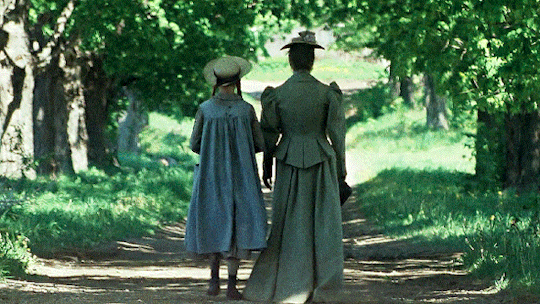





ANNE OF GREEN GABLES (1985)
Kindred spirits are not so scarce as I used to think. It's splendid to find out there are so many of them in the world.
#anne of green gables#anne of green gables 1985#aoggedit#anne shirley#diana barry#matthew cuthbert#marilla cuthbert#period drama#periodedit#perioddramaedit#kevin sullivan#megan follows#anna attempts photoshop#1k+#1k
2K notes
·
View notes
